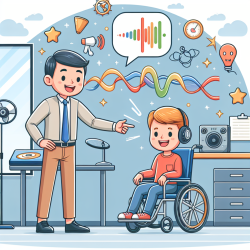Introduction
In the ever-evolving field of speech-language pathology, the integration of telepractice into school settings has emerged as a transformative approach. As speech-language pathologists (SLPs), we are driven by the desire to enhance educational outcomes for children, and telepractice offers a compelling avenue to achieve this. By leveraging data-driven decisions, we can tailor our approaches to meet the unique needs of each student, ensuring they receive the best possible care.
The Power of Data in Speech Therapy
Data is the cornerstone of effective speech therapy. By systematically collecting and analyzing data, SLPs can make informed decisions that lead to measurable improvements in student outcomes. Data allows us to:
- Identify patterns and trends in speech and language development.
- Track progress over time to ensure interventions are effective.
- Adjust therapy plans based on empirical evidence.
- Communicate progress to educators and parents effectively.
In the context of telepractice, data becomes even more crucial. With online platforms, we can easily record sessions, analyze interactions, and gather insights that inform our practice.
Telepractice: Bridging Gaps in School-Based Speech Therapy
Telepractice is revolutionizing the way speech therapy is delivered in schools. By providing services online, we can reach students who might otherwise have limited access to therapy. This approach not only expands our reach but also allows for a more flexible and personalized experience for students.
Research has shown that telepractice is as effective as traditional face-to-face therapy, making it a viable option for schools. It allows for:
- Increased access to qualified SLPs, especially in rural or underserved areas.
- Consistent therapy sessions without the need for travel.
- Integration of digital tools that enhance engagement and learning.
Implementing Data-Driven Telepractice in Schools
To maximize the benefits of telepractice, it is essential to implement a data-driven approach. Here are some steps to consider:
- Establish Clear Goals: Define specific, measurable objectives for each student. This provides a roadmap for therapy and helps in tracking progress.
- Utilize Technology: Use digital platforms that offer data collection and analysis features. This enables real-time tracking and adjustment of therapy plans.
- Regular Assessments: Conduct regular assessments to evaluate progress and make necessary adjustments to therapy approaches.
- Collaborate with Stakeholders: Engage with educators, parents, and students to gather feedback and refine strategies.
Conclusion: Taking the Next Step
As SLPs, our commitment to growing knowledge and enhancing outcomes is paramount. By embracing telepractice and leveraging data-driven decisions, we can ensure that our interventions are both effective and efficient. The next step is to integrate these practices into our daily routines, fostering an environment where every child can achieve their full potential.
Let's continue to explore and implement innovative solutions in speech therapy, driving positive change in schools and beyond.










